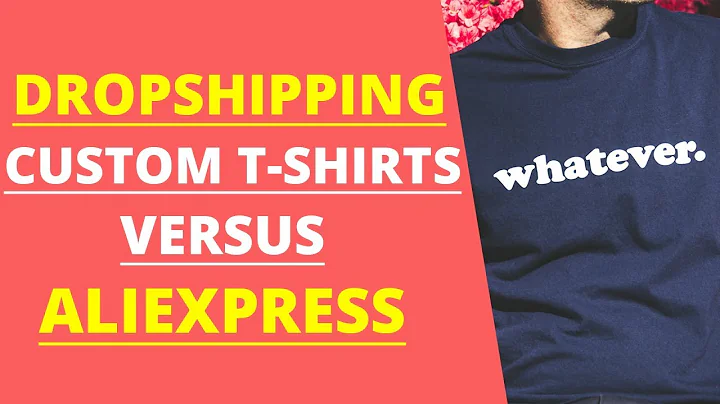The Ultimate Guide to Starting a Shopify Dropshipping Business
Table of Contents
- Introduction
- What is Drop Shipping?
- How does Drop Shipping work?
- Upfront costs of Drop Shipping
- Must-haves when starting your business
- Nice to haves
- Advertising methods for Drop Shipping
- Organic traffic
- Paid traffic
- Fulfilling orders in Drop Shipping
- Customer service in Drop Shipping
- Dealing with returns
- Managing general customer service
- Taxes in Drop Shipping
- Expectations in Drop Shipping
- Conclusion
Introduction
When I first started with Drop Shipping five years ago, I had numerous questions running through my mind. Questions like: What is Drop Shipping? How does it work? What are the upfront costs? How do I deal with customer service? Where do I find products? And most importantly, how can I find success? Now, after having worked as a Drop Shipper full-time for five years, I finally have all the answers for you. In this article, I will provide a comprehensive guide to Drop Shipping, addressing all these questions and more. Whether you are a beginner who knows nothing about Drop Shipping or someone who has heard about it and still has doubts, this article is perfect for you. So, grab a pen and paper, take some notes, and let's dive into the exciting world of Drop Shipping.
What is Drop Shipping?
Drop Shipping is a logistics model rather than a business model. It allows you to run a full-fledged e-commerce business without the need to hold any inventory. In the Drop Shipping model, you build a Shopify store, upload the products you want to sell, create ad creatives, drive traffic to your store, and when customers make a purchase, you send the order directly to your supplier. The supplier then ships the product directly to the customer, eliminating the need for you to handle and store inventory. This model is attractive because it significantly reduces upfront costs, making it an ideal choice for those starting their entrepreneurial journey online.
How does Drop Shipping work?
The Drop Shipping model involves several steps. First, you need to have a Shopify plan, which typically costs $39 per month. Shopify also charges a transaction fee of 2.4% to 3.9%, depending on the plan you select. However, using a special discount code, you can get Shopify for just $1 for the first three months. Once you have your Shopify store set up, you can choose a free theme and add relevant apps to enhance your store's functionality. It is essential to research and find reliable suppliers before running any advertisements. You should consider ordering the product you want to sell to your house first to test the supplier's reliability and product quality. This will also provide you with content material for marketing purposes.
Product cost is another consideration, and it varies depending on the product you choose to sell. Assuming a cost of $25, the upfront costs for starting a Drop Shipping business can range from $26 to $124 on the Shopify end. However, having a higher budget can significantly increase your chances of success and allow for more opportunities.
Upfront costs of Drop Shipping
Starting a Drop Shipping business involves both must-have and nice-to-have upfront costs. Let's discuss each of them in detail.
Must-haves when starting your business
The must-haves include essential items and services that you need to purchase to establish your Drop Shipping business. The first and foremost requirement is a Shopify plan, which costs $39 per month. However, with a special discount code, you can get Shopify for just $1 for the first three months. Additionally, Shopify offers a wide range of free themes that you can use to build your website. You can also add free apps from the Shopify app store to enhance your store's functionality. Some recommended free apps include Booster discounted upsells and Post-purchase checkout upsell.
Nice to haves
While not necessary, investing in certain tools, education, and apps can significantly increase your chances of success in Drop Shipping. These nice-to-haves are not essential but can enhance your store's performance. Some recommendable tools and services include product research tools like Mendea, which streamline the process of finding winning products, LLC registration, education platforms, and mentorship programs. These help you learn from experienced professionals and reduce your learning curve. It is important to note that while these nice-to-haves require a larger budget, they offer valuable insights and guidance, making them worthwhile investments.
Advertising methods for Drop Shipping
To generate sales in your Drop Shipping business, you need to drive traffic to your store. There are two primary advertising methods you can use: organic traffic and paid traffic.
Organic Traffic
Organic traffic refers to the traffic that comes to your store through organic means, mainly from social media platforms. The most popular platforms for organic traffic generation are Instagram Reels and TikTok. The key to driving organic traffic is to build your brand's social media presence while simultaneously promoting your store. By creating engaging and viral content related to your products, you can attract potential customers and direct them to your store. It is recommended to use User-Generated Content (UGC) as it tends to perform exceptionally well in organic reach. The advantage of organic traffic is that it is free. However, it requires consistent effort and exceptional content creation skills.
Paid Traffic
Paid traffic involves running advertisements on social media platforms like Facebook, Instagram, TikTok, or Pinterest. While there is a monetary investment, paid traffic offers more scalability and control over your marketing efforts. Some popular platforms for paid traffic are TikTok ads and Facebook/Instagram ads. Paid traffic allows you to reach a wider audience, target specific demographics, and track campaign performance. Although it involves more strategy and monetary risk, the benefits of paid traffic, such as scalability and faster growth, make it a viable option for Drop Shipping businesses.
Fulfilling orders in Drop Shipping
Fulfilling orders is a crucial part of running a successful Drop Shipping business. To ensure smooth order fulfillment, it is crucial to work with reliable suppliers. Before running any advertisements, thoroughly research suppliers and assess their reliability, product quality, and shipping times. One recommended option is to order the product you intend to sell to your house first. This allows you to evaluate the supplier's service and product quality, as well as use the product for content creation.
When it comes to fulfilling orders, there are multiple ways to handle them. One option is to use a platform like De-Essers on Shopify, which enables you to link your supplier to the product and place orders manually. Another option is to have the supplier ship the product directly to your house, although this method is not ideal as it can lead to higher shipping costs and customer dissatisfaction. Alternatively, you can consider using a virtual mailing address service, which provides a dedicated address for receiving returns and business documents. This service offers convenience and organization, keeping all your mail in one place and facilitating efficient handling of returns.
Customer service in Drop Shipping
Effective customer service is vital for maintaining customer satisfaction and building a successful Drop Shipping business. Customer service in Drop Shipping primarily involves dealing with returns and managing general inquiries.
Dealing with returns
While it is best to avoid returns as much as possible by providing accurate product descriptions and shipping information, returns are an inevitable aspect of business. When returns occur, it is essential to have a plan in place. One option is to have customers send the product directly back to the supplier, which is not recommended as it can lead to higher postal costs and customer dissatisfaction. Another option is to have customers send returns to your house, but this may not be practical for multiple returns. The best approach is to use a virtual mailing address service, which can handle returns efficiently and ensure proper customer service.
Managing general customer service
Managing general customer inquiries is an essential part of running a Drop Shipping business. Initially, you can handle customer service yourself. However, as your business grows, it becomes necessary to delegate this task to a virtual assistant (VA). Hiring a VA from freelance platforms like Fiverr or Upwork can significantly reduce the time spent on customer service. Train them on how to respond to common inquiries and flag any important or complex issues for your attention. This delegation allows you to focus on other aspects of your business while ensuring excellent customer service.
Taxes in Drop Shipping
Taxes are an important consideration for any business, including Drop Shipping. However, it is crucial to consult a tax professional to ensure compliance with specific country and state regulations. Hiring a tax accountant who specializes in e-commerce can help navigate the complexities of tax obligations. When it comes to filing taxes, it is recommended to export all financial records, including revenue, product costs, and advertising costs, and provide them to your tax accountant. They will then prepare and file your taxes, ensuring compliance and minimizing the risk of legal issues.
Expectations in Drop Shipping
It is essential to have realistic expectations when starting a Drop Shipping business. While some online content may portray Drop Shipping as a get-rich-quick scheme, the reality is different. Drop Shipping requires learning about marketing, angles, ad creatives, and web design. Additionally, you will encounter trial and error during product selection and marketing campaigns. Therefore, it is crucial to have patience, perseverance, and a willingness to put in the necessary time and effort. While success timelines may vary, dedicating consistent effort and continuously improving your strategies will eventually lead to profitability and scalability.
Conclusion
Starting a Drop Shipping business can be a rewarding and profitable venture, especially with the right knowledge and strategies. It is crucial to understand the logistics and intricacies of Drop Shipping, including upfront costs, advertising methods, order fulfillment, customer service, taxes, and expectations. By following this comprehensive guide and investing time and effort, you can successfully launch and grow your Drop Shipping business. Remember, success in Drop Shipping is achievable with dedication, learning, and adaptability.



















